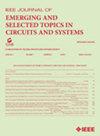Low-Power Multiversion Interpolation Filter Accelerator With Hardware Reuse for AV1 Codec
IF 3.8
2区 工程技术
Q2 ENGINEERING, ELECTRICAL & ELECTRONIC
IEEE Journal on Emerging and Selected Topics in Circuits and Systems
Pub Date : 2024-12-25
DOI:10.1109/JETCAS.2024.3523246
引用次数: 0
Abstract
In modern video encoders, sub-pixel motion models are used to represent smoother transitions between neighboring frames, which is specially useful in regions with intense movement. The AV1 video codec introduces adaptive filtering for sub-pixel interpolation in the inter-frame prediction stage, enhancing flexibility in Motion Estimation (ME) and Motion Compensation (MC), using three filter types: Regular, Sharp, and Smooth. However, the increased variety of filters leads to higher complexity and energy consumption, particularly during the resource-intensive generation of sub-pixel samples. To address this challenge, this paper presents a hardware accelerator optimized for AV1 interpolation, incorporating energy-saving features for unused filters. The accelerator includes one precise version that can be used for both MC and ME and two approximate versions for ME, designed to maximize hardware efficiency and minimize implementation costs. The proposed design can process videos at resolutions up to 4320p at 50 frames per second for MC and 2,656.14 million samples per second for ME, with a power dissipation ranging between 21.25 mW and 40.06 mW, and an average coding efficiency loss of 0.67% and 1.11%, depending on the filter type and version.低功耗多版本插值滤波器加速器与硬件复用AV1编解码器
在现代视频编码器中,亚像素运动模型用于表示相邻帧之间更平滑的过渡,这在运动剧烈的区域特别有用。AV1视频编解码器在帧间预测阶段引入了亚像素插值的自适应滤波,增强了运动估计(ME)和运动补偿(MC)的灵活性,使用三种滤波器类型:常规,锐利和平滑。然而,过滤器种类的增加导致了更高的复杂性和能量消耗,特别是在资源密集型的亚像素样本生成过程中。为了解决这一挑战,本文提出了一种针对AV1插值进行优化的硬件加速器,并结合了未使用滤波器的节能特性。加速器包括一个可用于MC和ME的精确版本和两个用于ME的近似版本,旨在最大限度地提高硬件效率并最小化实施成本。所提出的设计可以处理分辨率高达4320p的视频,MC为每秒50帧,ME为每秒2665614万样本,功耗范围为21.25 mW至40.06 mW,根据滤波器类型和版本的不同,平均编码效率损失为0.67%和1.11%。
本文章由计算机程序翻译,如有差异,请以英文原文为准。
求助全文
约1分钟内获得全文
求助全文
来源期刊

IEEE Journal on Emerging and Selected Topics in Circuits and Systems
ENGINEERING, ELECTRICAL & ELECTRONIC-
CiteScore
8.50
自引率
2.20%
发文量
86
期刊介绍:
The IEEE Journal on Emerging and Selected Topics in Circuits and Systems is published quarterly and solicits, with particular emphasis on emerging areas, special issues on topics that cover the entire scope of the IEEE Circuits and Systems (CAS) Society, namely the theory, analysis, design, tools, and implementation of circuits and systems, spanning their theoretical foundations, applications, and architectures for signal and information processing.
 求助内容:
求助内容: 应助结果提醒方式:
应助结果提醒方式:


